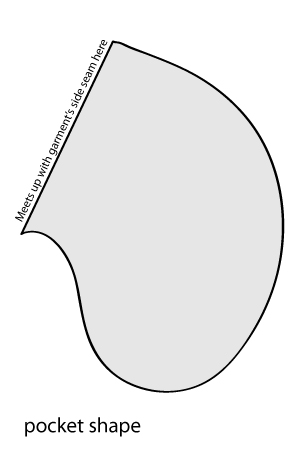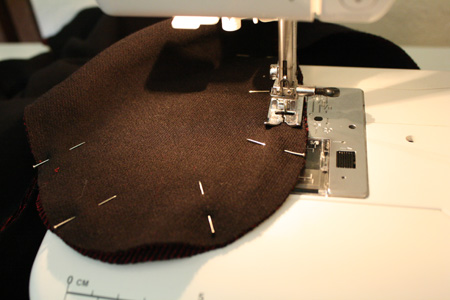In this world of imperfections, one of the niggling problems of everyday life is the lack of functional pockets in women’s clothing. I’m certain I’ve mentioned it before. Someone as addicted to lip balm as I am starts to twitch when made to go without pockets.
Unfortunately, I myself have fallen into the trap of making myself dresses without pockets, because they wouldn’t work with the fit and so on and so forth. Tragic. So I was determined that my latest shirt-to-dress modification must have a pocket, and I’m going to show you just how simple it is to make said pocket. Thing is, you can use this method to put a pocket in a new, made-by-you dress or skirt, or you can use it to insert a pocket into an already existing, factory made garment.
Before I get into the tutorial, though, I have a story and a guest appearance. The guest is my mother, and the story explains why we’re wearing dresses that sort of match but not really.
Don’t know if I’ve mentioned it before, but the sewing machine I do so much of my crafting on was my university grad gift from my parents. My mother expected me to use it (for hemming pants, making cushions, mending stuff), but never to this extent; she taught me how to sew when I was a kid and I hated it, vocally and with great passion. So my sudden active desire to stitch bits of fabric together bowled her right over. When she managed to pick herself back up, she seemed to decide she’d better encourage this habit, so she regularly sends me fabric and thread and buttons and such.
She’s certainly delighted with the things I make, but I think she’s also relieved that I am becoming a kindred sewing spirit, so that I will bless and not curse her for leaving me with a gobsmacking amount of fabric when she dies. My mother, you see, is actively pursuing the ideology of “whoever dies with the most fabric wins.” My mother likes to win.
Several months ago my mom sent me a men’s 3XL maroon shirt, along with a photo of her wearing an identical garment. She explained that she was issuing a design “challenge.” She and I would make ourselves dresses from the same shirt, then contrast and compare. Below are the results (my parents having just made their annual pilgrimage to visit their darling daughter.) A special thank you to my ever-so-patient father, who never had any desire to be a fashion photographer. Though he did comment that real models would probably be a lot more cooperative.

It’s interesting to see the two completely different (yet, in some ways similar) things we did with the same original garment. Mom went for much more detail on hers, while I kept mine pretty simple. We both changed the neckline, but made use of some of the original collar and buttons. Mom put a very clever new hemline on her dress to lengthen it (I forgot to take close-up shots, but perhaps she’ll send me one) that consisted of several arrow-ended strips of fabric overlapping one another, all the way around the dress. She also put hidden pockets in between those black stripes on the skirt, which are actually just bits of the shirt but turned inside out (hence the colour difference). I used the sleeves from my shirt to make a waistband that gathers at either side, and brought the neckline down further in back than in front. We both had leftover buttons – mom gave me hers and I made a pair of earrings to match my dress.
Here’s what our photographer thought of all this falderah.
————————————————————–
What you’ll need:
- A dress or skirt in need of a pocket
- fabric for the pocket (a lightweight fabric is good – cotton, perhaps – and it doesn’t have to be a very big piece, though remember you’ll need a back and front to the pocket)
- thread to match the fabric of the dress or skirt
- fabric scissors
- straight pins
- sewing machine
- iron & ironing board (optional – you can do the project without these, they’re just to flatten seams down and make stuff a little neater and easier to work with)
- seam ripper (if you’re inserting a pocket into an already-existing garment)
————————————————————–
1) If you are inserting a pocket into an existing, finished skirt or dress, turn the garment inside out and choose a spot below the waist where a pocket would be comfortable for you. Mark off about 8 to 10 inches with pins, and use your seam ripper to pick out the stitches between the pins, so you have an opening in the garment’s side. Then turn the garment right side out.
2) Start with the skirt or dress right side out. Place two pins 8 to 10 inches from each other along the garment’s side, at the height you’d like the pocket to be. Remember that the pocket will descend several inches below this opening, so make sure you don’t put the opening too low or the pocket will show beneath the bottom hem of the skirt.
If you are putting a pocket into a new skirt, you can do this step before you sew up the skirt’s side seams, or you can sew the side seams, leaving a gap where the pocket will go. I went with the latter method.
3) From whatever scrap fabric you have, cut a pocket shape. The pocket must have one straight edge that’s about 1 inch shorter than the opening in the skirt’s side. As in my case, the size and shape of scrap fabric you’re using may dictate the exact size and shape of the pocket. I’d recommend using a fairly light fabric, so it doesn’t bulge under the skirt. I used the same fairly thick jersey knit the dress itself was made from, and it bulges a bit. So here’s an instance of “do as I say, not as I do.” Make sure you cut two identical pieces of fabric, one for each side of the pocket.
Below is a general idea of a pocket shape. It needs to curve downwards, so that the opening is above the space that holds things.
4) Pin one of the pocket pieces to the front of the skirt, so the straight edge matches up with the skirt’s side seam, between the pins. Pin the other pocket piece to the other side of the skirt. The two pieces should mirror each other through the skirt.
5) Now sew the straight edge of each pocket piece to the straight edge of the side of skirt it’s pinned to. Do NOT sew the two sides of the skirt together, or you’ll close up the pocket and, well, there won’t be a pocket.
6) Turn the garment inside out. Iron the pocket-to-skirt straight seams you just sewed.
7) Pin the two sides of the pocket together, all the way around.
8) Now, starting along the side seam of the actual skirt, sew down to where the pocket starts, all around the pocket’s edges, and back onto the actual skirt again. (See the dotted white line in the photo below.) If this is being put into a new skirt, you can sew up the rest of the skirt’s side seams at the same time. If you’re inserting a pocket into an existing skirt, make sure you start sewing an inch or two above where the side seams are ripped out, so there is no gap.
9) Now turn the dress right side out again, and iron if desired. Enjoy your new pocket. May your chapstick always be close at hand!





















